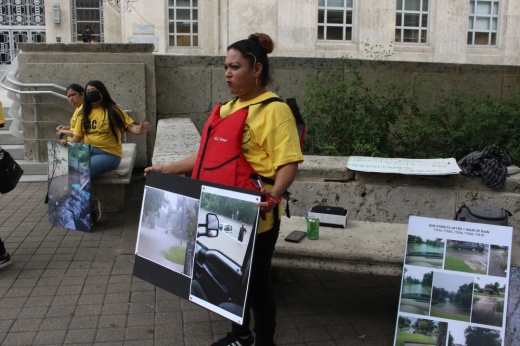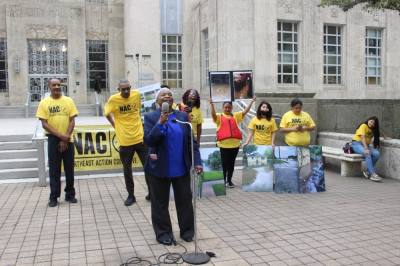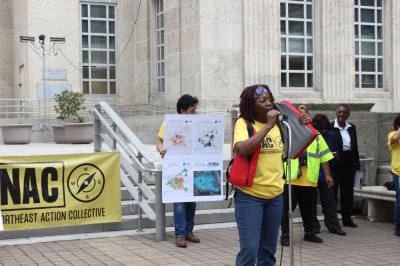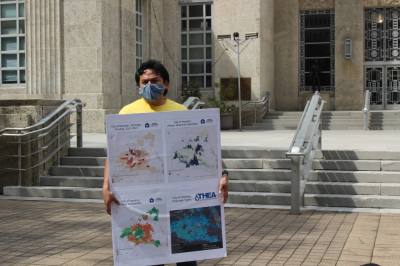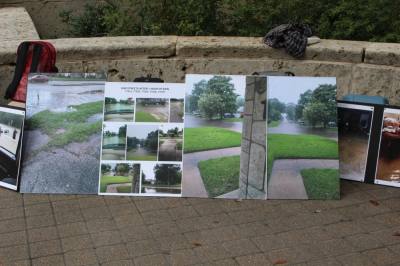Northeast Action Collective and West Street Recovery organized a protest Feb. 22 to ask the city of Houston to take responsibility for the investment and maintenance of infrastructure in low-income neighborhoods.
Both groups were created by neighbors who, after Hurricane Harvey, wanted to advocate for flood mitigation and equitable recovery. One protestor, Sandra Edwards, wore a life jacket to represent the struggles NAC has gone through while dealing with the city and floods.
“We are here because we are sick and tired of being sick and tired,” Edwards said. “This life jacket represents that we’re tired of floating through their mess. We have to have a life jacket to stay afloat, and we have to have a life jacket to walk out of the house because it floods all the time.”
Protestor Felix Kapoor said the organizations have four demands for the city: increase investment in drainage for neighborhoods with people of color; maintain and repair open ditches and other drainage infrastructure on a regular basis; improve 311, the citizen request line for the city of Houston, to make it more effective; and increase transparency and accessibility with drainage infrastructure governing.
A Feb. 21 tweet from WSR said 84% of open ditches are located in Houston City Council’s District B, the district NAC resides in. Residents said they see these ditches get easily clogged, needing regular maintenance.
According to Houston Public Works, open ditches are a shared responsibility between a homeowner and the city, with the homeowner having most of the responsibility over maintenance. The city asks residents to instead report incidents to 311. However, coinciding with NAC’s third demand, resident David Espinoza, a speaker at NAC’s Feb. 22 protest, claimed 311 has done nothing for the residents in his district.
“We have been misled and run in circles,” Espinoza said. “We want transparency, and we want action. The people kept telling us to call 311. We called. 311 calls don’t produce results.”
Julia Orduña, Texas Housers’ Southeast Texas regional director, said the northeast neighborhoods and other neighborhoods with people of color have not received sufficient drainage investment.
“Our communities flood even during normal rains, and major rainfalls like [Tropical Storm] Imelda and [Hurricane] Harvey are catastrophic,” Orduña said. “Street flooding limits mobility and opportunities for these communities. The poor drainage makes [the community] feel anxious and depressed and angry.”
Protestor Veronica Medina spoke on what she experienced during Harvey. She said she and her family lost everything in the flood. Now, she just wants the area to be fixed to better mitigate future flood events.
“We’re always scared when it rains,” Medina said, “I wish I could put a life vest on my house to lift it up so it wouldn’t flood.”
After protesting, eight members from the NAC and WSR spoke on the drainage concerns in their area at Houston City Council’s Feb. 22 public session. Alice Liu, WSR’s co-director of communications, rebuild and fundraising, said the group was there to address the inequity with drainage spending in Houston. She said the city neglects resident health and well-being by not investing in the drainage system, specifically for the low-income areas with people of color.
Martha Castex-Tatum, who represents District K on Houston City Council and serves as vice mayor pro tem, said the city is aware of the issue and knows there needs to be improvement. She also spoke on the concerns of the city not answering reports, telling residents they should contact their council members to accompany the 311 call in order to resolve an issue.
District B Council Member Tarsha Jackson said there have been studies done on the area and that projects to help flooding should begin in May.
“We have been working for a long time on the drainage issue in District B,” Jackson said. “There is some activity happening, but we still have a lot of work to do.”




